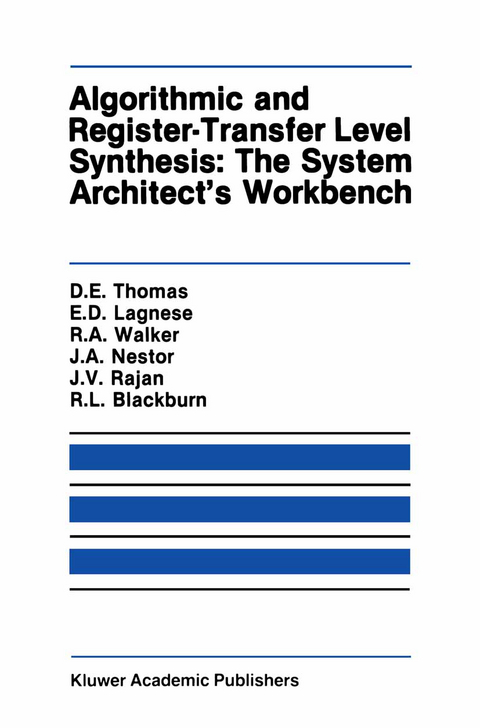
Algorithmic and Register-Transfer Level Synthesis: The System Architect’s Workbench
Springer-Verlag New York Inc.
978-1-4612-8815-2 (ISBN)
1. Introduction.- 1.1. Synthesis of Integrated Circuits.- 1.2 The System Architect’s Workbench.- 1.3 Contrasting Approaches to Synthesis.- 1.4. Historical Note.- 1.5. Overview of the Book.- 2. Design Representations and Synthesis.- 2.1 The Model of Design Representation.- 2.2. Behavioral Representations at the ALGORITHMIC Level.- 2.3. Behavioral and Structural Representations at the REGISTER-TRANSFER Level.- 2.4. Modeling ALGORITHMIC and RT Level Synthesis.- 2.6 Summary.- 3. Transformations.- 3.1. Vtbody Transformations.- 3.2. SELECT Transformations.- 3.3. Adding Processes To The Workbench.- 3.4. Process Creation.- 3.5. Pipestage Creation.- 3.6. Structural Transformations.- 3.7. Summary.- 4. Architectural Partitioning (APARTY).- 4.1. Architectural Partitioning.- 4.2. Previous Work: Clustering.- 4.3. Multi-Stage Clustering.- 4.4. Methodology.- 4.5. Guiding Other Synthesis Tools.- 4.6. A Partitioning Example.- 4.7. Summary.- 5. Control Step Scheduling (CSTEP).- 5.1. The Scheduling Problem.- 5.2. Related Work.- 5.3. The CSTEP Scheduling Approach.- 5.4. Scheduling Examples.- 5.5. Summary.- 6. Data Path Allocation (EMUCS).- 6.1. Other Data Path Allocators.- 6.2. EMUCS Overview.- 6.3. Initialization.- 6.4. Prebinding and Manual Binding.- 6.5. Automatic Binding.- 6.6. Post-Processing.- 6.7. Finish Up.- 6.9. Summary.- 7. Microprocessor Synthesis (SUGAR).- 7.1. Organization of SUGAR.- 7.2. Behavioral Transformations.- 7.3. Execution Unit Organization Analysis.- 7.4. Code Generation.- 7.5. Code Selection.- 7.6. Register and Bus Assignment.- 7.7. Phase Structure of SUGAR.- 7.8. Summary.- 8. Synthesis Results.- 8.1. Fifth Order Digital Elliptic Wave Filter.- 8.2. Kalman Filter.- 8.3. BTL310.- 8.4. MCS6502.- 8.5. MC68000.- 8.6. Summary.- 9. Correlating the Multilevel DesignRepresentation (CORAL).- 9.1 Linking Design Representations.- 9.2 Applications.- 9.3 Summary.- 10. Observations and Future Work.- 10.1. Are The Two Synthesis Paths Different?.- 10.2. You Need More Than Synthesis.- 10.3. Algorithmic Level Synthesis.- 10.4. Logic Synthesis, Module Generation and Physical Design.- 10.5. Design Languages.- 10.6. Summary.- References.
| Erscheint lt. Verlag | 16.9.2011 |
|---|---|
| Reihe/Serie | The Springer International Series in Engineering and Computer Science ; 85 |
| Zusatzinfo | XIV, 306 p. |
| Verlagsort | New York, NY |
| Sprache | englisch |
| Maße | 155 x 235 mm |
| Themenwelt | Informatik ► Weitere Themen ► CAD-Programme |
| Technik ► Elektrotechnik / Energietechnik | |
| ISBN-10 | 1-4612-8815-0 / 1461288150 |
| ISBN-13 | 978-1-4612-8815-2 / 9781461288152 |
| Zustand | Neuware |
| Haben Sie eine Frage zum Produkt? |
aus dem Bereich


